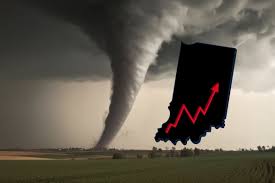As severe tornadoes struck from Kansas to Kentucky, a stretched-thin National Weather Service found itself scrambling to respond.
The agency’s Jackson, Kentucky office had begun shutting down overnight due to significant cuts imposed by Elon Musk’s Department of Government Efficiency. However, staff worked overtime Friday night to monitor deadly storms that claimed nearly 20 lives in the Jackson forecast region. This situation is expected to repeat itself, with the U.S. projected to experience more tornadoes this year than in 2024—the second-highest tornado year on record. Forecasters warned that on Tuesday, there was at least a 10% tornado risk for 10.6 million people across parts of Missouri, Arkansas, Oklahoma, and Texas. Experienced meteorologists voiced concern about the agency’s capacity to keep pace amid ongoing budget cuts.

Rich Thompson, lead operations forecaster at the NWS Storm Prediction Center in Norman, Oklahoma, said the work is getting done but acknowledged staffing reductions have “made it more challenging.”
“It has made it tough for local offices to cover all essential responsibilities. But most staff take these duties seriously, so we’re committed to doing whatever it takes,” Thompson said. “I hope this staffing shortage doesn’t last long-term… It would be difficult to maintain this level of effort for months or years.”
NWS spokesperson Erica Grow Cei noted the Jackson office “remained fully staffed during the event thanks to surge staffing” and received help from nearby offices.
A Leaner Weather Service Faces Growing Extreme Weather
The Storm Prediction Center recorded 883 local tornado reports this year as of Monday, a 35% increase over the average for this point in the year.
Many former weather service employees—especially those dismissed under the Trump administration—remain connected to the agency’s internal operations. They describe a service that is still managing to issue forecasts and warnings on time but is nearing a breaking point.
“They’ll keep stepping up as long as possible, but people can only work 80 to 120 hours a week for so long,” said Elbert “Joe” Friday, a former weather service director. “Eventually, they’ll be so exhausted they won’t be able to interpret radar correctly.”
Tom DiLiberto, a meteorologist and spokesman fired during earlier layoffs, compared the situation to a leaky boat patched with limited duct tape. “You keep moving the tape to cover different holes, but eventually, you run out.”
As of March, some offices responsible for issuing tornado warnings Friday and Sunday had vacancy rates above the critical 20% threshold identified by outside experts. Jackson had a 25% vacancy, Louisville, Kentucky, 29%, and Wichita, Kansas, 32%, according to data from weather service employees obtained by the AP.
While tornado prediction technology has advanced, radars cannot substitute for a well-rested staff who must determine how severe and long-lasting storms will be, and how best to communicate risks to the public, said Karen Kosiba, managing director of the Flexible Array of Mesonets and Radars (FARM) research network.
“There just aren’t enough personnel to handle everything,” said University of Oklahoma meteorology professor Howard Bluestein, who chased six tornadoes on Sunday. “Understaffing could affect forecast quality.”
Cuts Impact Different Aspects of Weather Service Operations
Former weather service Director Louis Uccellini noted budget cuts have drastically reduced the number of weather balloon launches—vital for accurate forecasting. Additionally, employees are no longer allowed to travel to train local disaster officials on responding to dangerous weather warnings.
Although the recent tornado outbreak is near typical for this time of year, Thompson and other experts said.
Tornado formation requires warm, moist air from the Gulf of Mexico meeting storm systems moving along the jet stream—a river of air bringing weather fronts from west to east—explained Thompson, Bluestein, and Harold Brooks from the National Severe Storm Laboratory.
“The Gulf is delivering much more moisture than before,” said Bluestein. “That increases the chance of stronger storms, which is unusual.”
Gulf temperatures are a few degrees warmer than normal for this time of year, according to the weather service.
While the link between climate change and tornadoes is less understood than its connection to heavy rain or heat waves, experts suggest the atmosphere is being supercharged on some days and less favorable for storms on others, said Ohio State University atmospheric sciences professor Jana Houser.
Scientists also observe more tornadoes occurring in January through March—months previously too cold for twisters—especially in Alabama, Georgia, Mississippi, and Tennessee.
More people living in tornado-prone areas raises the stakes, Brooks said. This is why Uccellini and others warn of growing risks to life and property.
“When facing this kind of threat with understaffing, something’s bound to slip through the cracks,” Uccellini said. “I can’t say when, but it will happen.”


This is really alarming. We rely so much on accurate forecasts — losing skilled meteorologists during a time of increasing storms is a serious concern.
A very timely article. Public safety depends on early warnings, and with more tornadoes forming, we need more trained experts, not fewer.
Thank you for shedding light on this issue. I hope it pushes more investment into meteorology programs and better support for the professionals behind the scenes.